Before we set out from Panama we did lots of reading and internet browsing to get as much info about French Polynesia as possible, but while there was an abundance of prevailing wind and cyclone statistics, other parameters like temperature/swell/rainy seasons/etc. were hardly mentioned or contradicting in different sources. We made the mistake of arriving shortly before the far chillier than expected southern winter in the Gambier Islands, fled from the cold to the Marquesas in August and suffered there in the rolly anchorages during the season with the highest swell… After spending two years cruising French Polynesia we have gathered quite some info and experience about this diversified cruising area. Here’s a short summary of the archipelagos and their climates:
The trade winds are predominantly from the E between February and April, from the E to SE between May and November and from the E to NE in December and January. Note that compared to the Caribbean, the trade winds are far less reliable here in the South Pacific. In southern winter the neat parallel isobars sailors wish for are frequently distorted by fronts and troughs (products of the South Pacific Convergence Zone) and often they are squeezed together closely (causing strong trades) when mighty highs move by nearby in the subtropics. In southern summer the highs move by further south (causing only light trades) and branches of the convergence zone may linger around rather stationary (shifting winds, rain).
To learn more about weather patterns in the tropical South Pacific, you may read our article published in the Cruising World magazine. It’s also available on-line on the Cruising World webpage.
To learn more about prevailing winds, you may check out our atlas of prevailing ocean winds.
Marquesas
The northernmost group of Fr. Polynesia lies outside the cyclone belt. The high, spectacular mountains are great for hiking, but the often murky, dark water discourages snorkeling (even though you may have impressive encounters with manta rays and groups of dolphins around the anchorages). During southern winter high swell from depressions that move by far south make the open anchorages very uncomfortable. The nonos (biting little flies) are always a nuisance, but the situation’s better during the dry season (October to April).
Gambier Islands
The Gambier with their perfect mixture of high, mountainous islands within a clear lagoon, healthy coral reefs and pretty motus are best visited during southern summer (the Gambier have well-protected anchorages and a low risk of cyclones, particularly during El-Niño-neutral periods), when it’s hot (up to 30 degrees), but usually pleasantly breezy (although there may be some rainy days in-between). In southern winter (July to September) the temperatures drop to 18 or even 15 degrees, which feels much chillier than it sounds when it’s blowing hard and raining.
Tuamotus
The low atolls with their beautiful motus feature sea bird colonies and pristine reefs. From June to October humpback whales are often sighted here. Cyclones are rare in this archipelago, but sitting one out in the unprotected anchorages must be a nightmare so we avoid cruising there in the cyclone season (even though we know many people who do). During the strong trade winds in July and August it’s colder, high waves fill up the lagoons when it’s blowing hard, so the currents in the passes are faster and the choice of anchorages is limited.
Tahiti and the Society Islands
The high, mountainous islands with their pretty, turquoise lagoons bear the most famous names in French Polynesia. The lush mountains are great for hiking, but unfortunately the coral in the lagoons is mostly dead, hotels dot the shores and you’ll have to share the anchorages with many charter boats. During the cyclone season in southern summer (December to April) the climate is hot, humid and oppressive and in times of an active SPCZ many lows pass over the islands. The best time to visit is during the cooler and drier months between June and September, that’s also when the humpback whales roam this area.
Austral Islands
The Îles Australes are the least visited archipelago and that’s not without reason. Southern summer would be the most pleasant time, but unfortunately that’s also the cyclone season and these islands are right in the path of the depressions and cyclones that move down from the Cook Islands or Tahiti particularly whenever the South Pacific Convergence Zone (SPCZ) is very active. After that it’s already southern autumn when frequent depressions start moving by in the South, sending high swell and strong winds up. We visited Raivavae in May. Another option might be November, when it’s already warm, but the cyclone season is only in its beginnings.
See-them-all-in-one-year itinerary
The laws are changing frequently and plenty of outdated information and rumours are on the internet. For EU citizens it’s easy as they can stay for an unlimited time without visa and since spring 2014 import tax on the boat is only due after 3 years (unless you get a job/buy property and become a resident, then import tax is due immediately). It’s therefore very tempting not to rush over the Pacific in one season, but to linger a bit longer in this beautiful, diversified cruising area. Here’s how we’d fit visiting all five archipelagos at their best into one year (or 1 1/2) of cruising in French Polynesia (given ‘normal’ weather conditions, but of course you can never rely on the weather, especially in El-Niño years…):
If you set out in December/January from Central America/Galapagos, you should have fairly reliable wind on the way to the Marquesas and you can reach the Marquesas in February during the dry season before the fleet of puddle jumpers starts crowding the anchorages. Southerly swell should not be an issue at this time of the year, so with a bit of luck you’ll spend quiet nights in the open anchorages (maybe even without a stern anchor).
Continue towards the Tuamotus in April after the end of the cyclone season, when it’s still warm and not too windy to explore the motus all around the lagoons and enjoy snorkeling the spectacular passes.
Head down to the Societies in July in time to admire the dancing and drumming during the Heiva festival, go hiking in the pleasant breezy weather and explore the lagoons.
Start looking for weather windows to sail to the Australs in October/November and explore the least visited archipelago in November or December.
Finding a weather window to sail to the Gambiers with favorable winds might require some patience. Convergence zones often bring northerly winds that facilitate easting. Arrive in the Gambier in December/January and enjoy exploring the numerous anchorages all around the huge lagoon during the summer months. This way you have also saved the highlight of French Polynesia (in our humble opinion ![]() ) until the end and you won’t have to compare all the other islands to the Gambiers like we did.
) until the end and you won’t have to compare all the other islands to the Gambiers like we did.
On the way west there’s still time to see more of the Tuamotus and Societies before heading on in the next sailing season, or you might even decide that you need another year to enjoy French Polynesia ![]()
Donate
If you find our guides useful you might want to buy us a drink when you meet us somewhere around in person or make a donation to our PayPal account.
Climate Charts



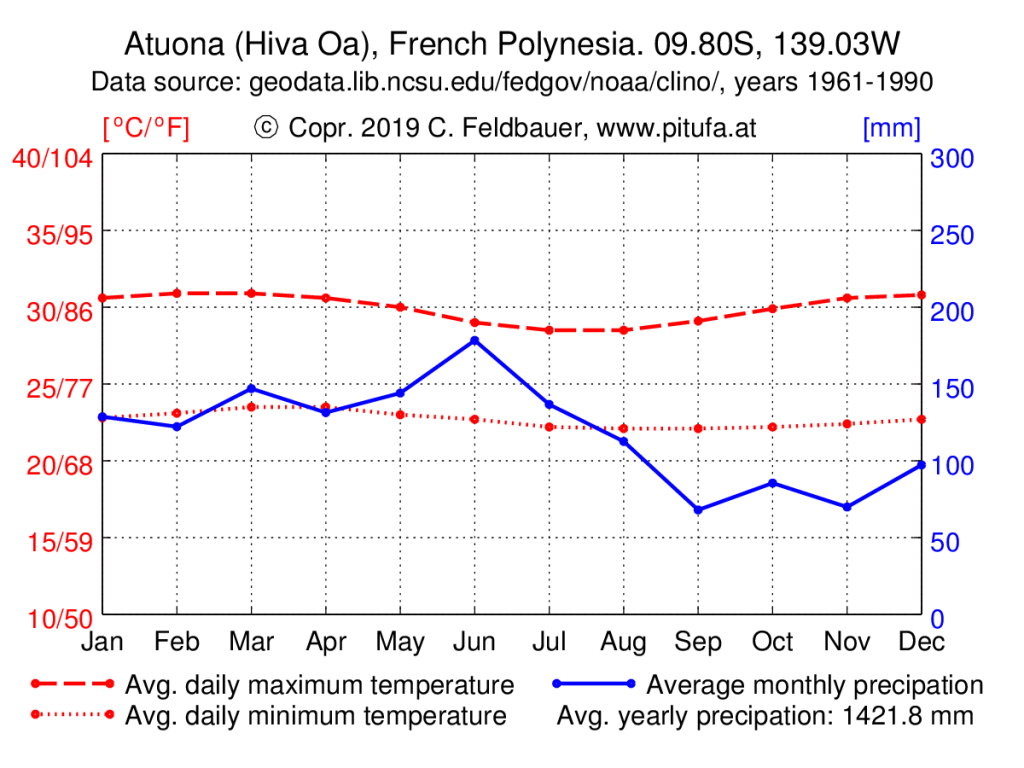
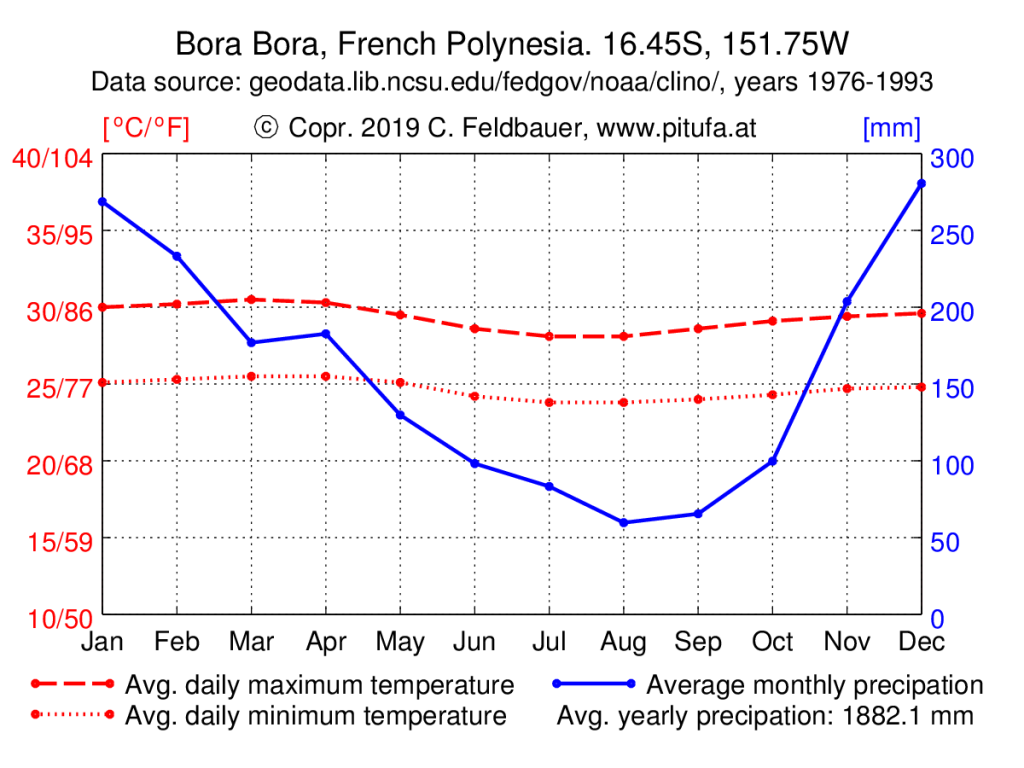
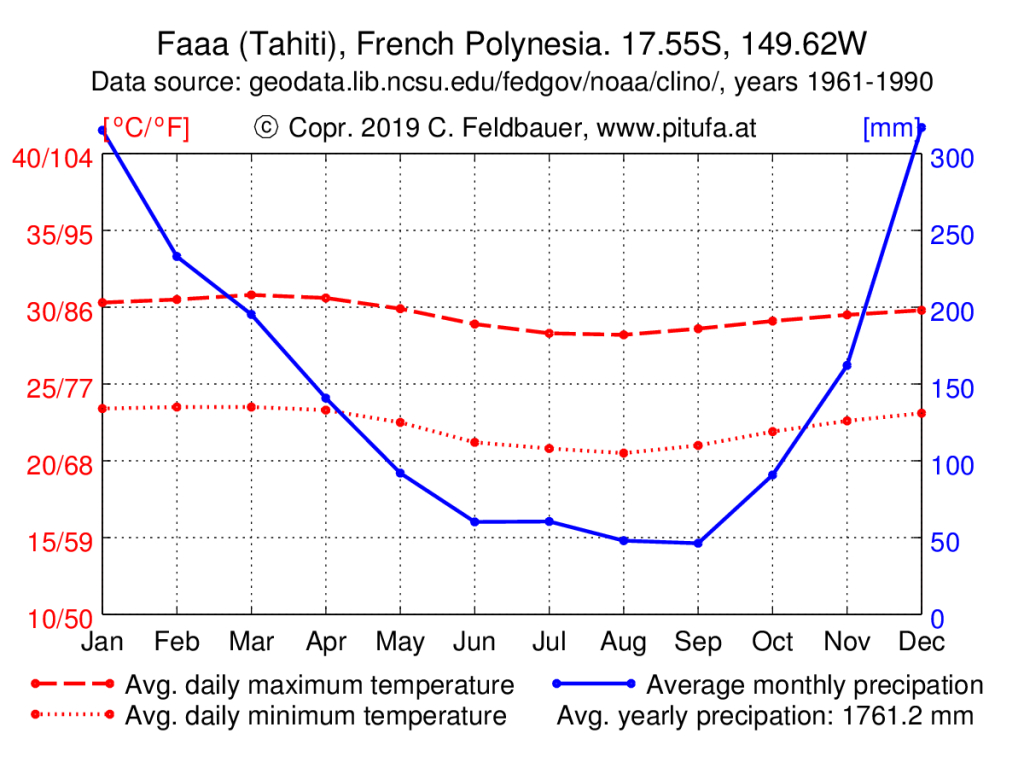
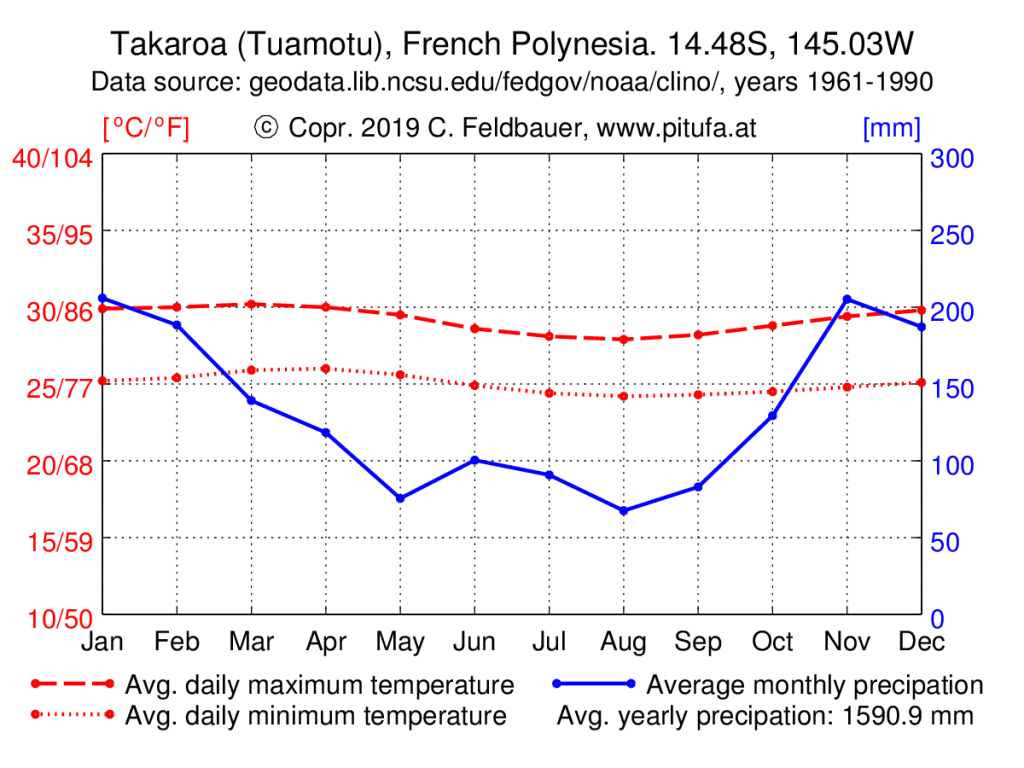
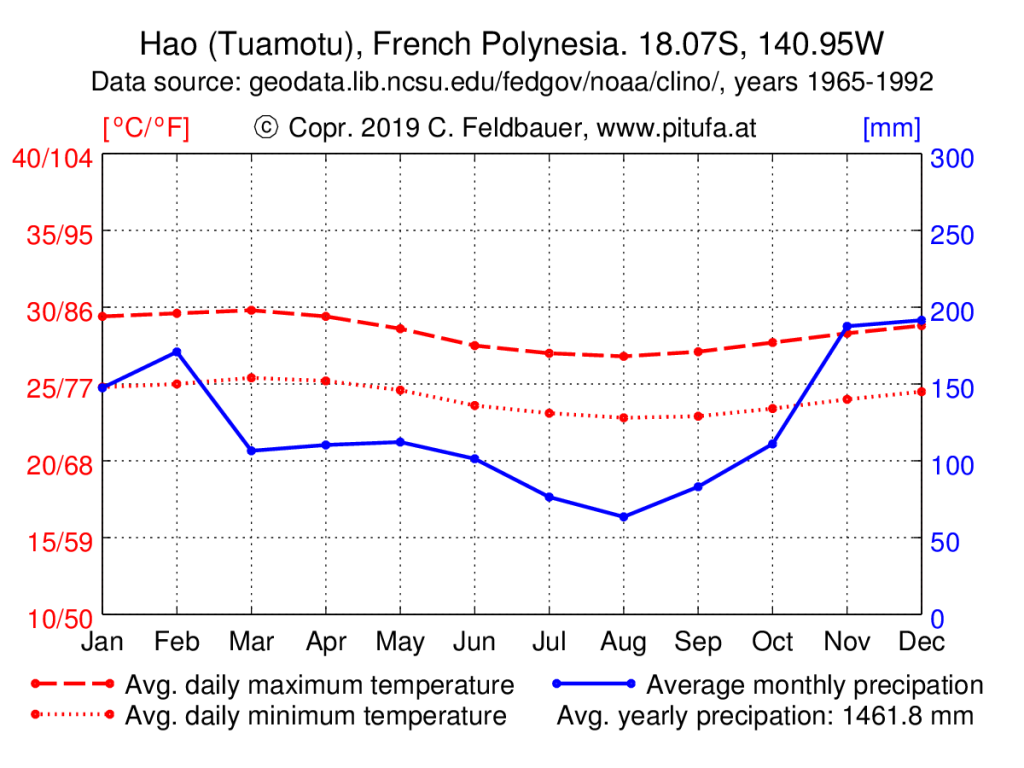
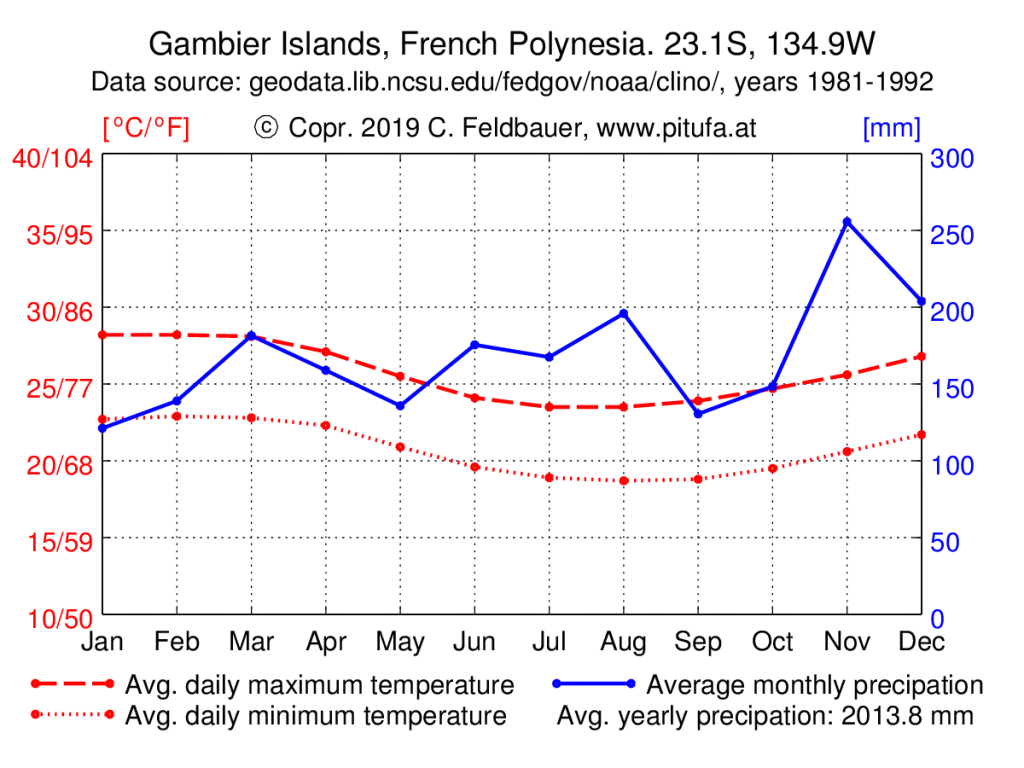
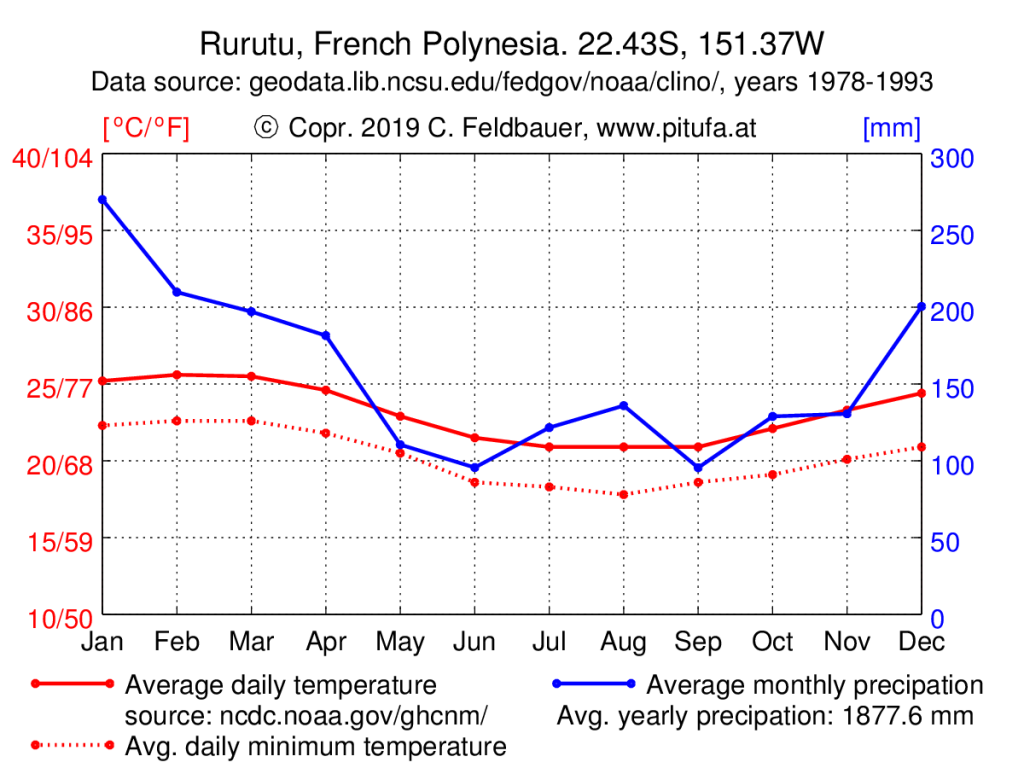
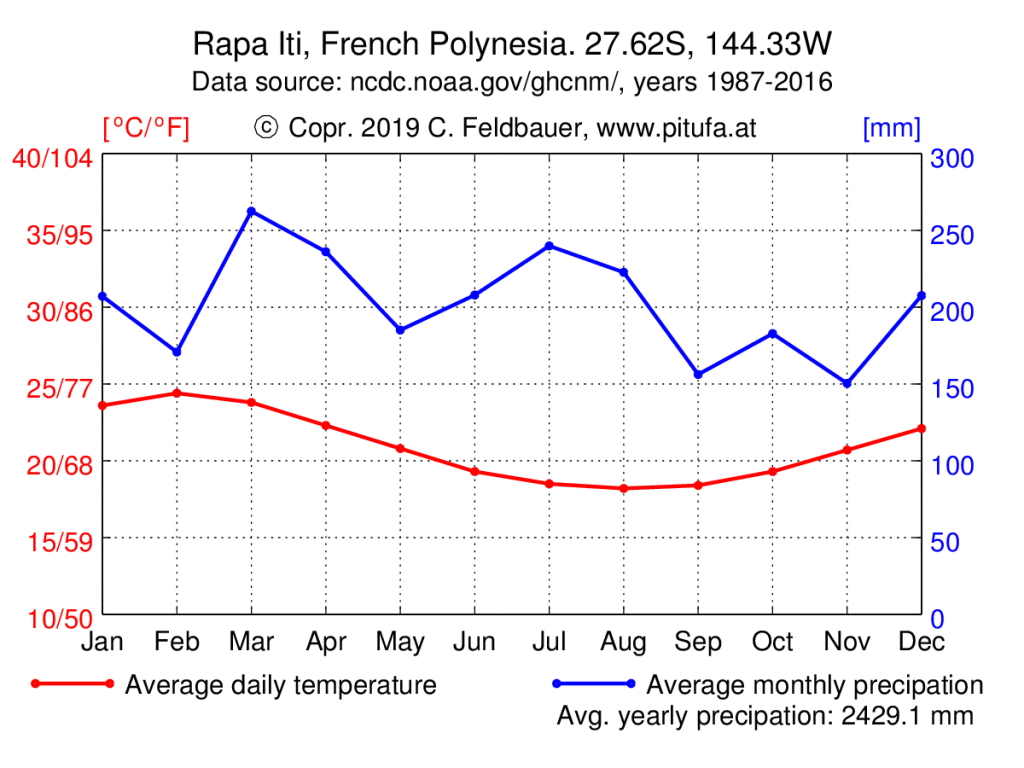





5 comments
Ilona says:
July 16, 2016 at 8:28 am (UTC 0)
Very useful information, thanks!!
Graham Openshaw says:
March 17, 2019 at 8:06 pm (UTC 0)
Thanks for the great tips! This was something we were struggling to get our heads around. If you have a moment we would really appreciate some ideas for an itinerary as we are planning to be in FP from July 2019 until April 2020.
Christian says:
March 23, 2019 at 12:42 am (UTC 0)
Hi Graham,
When you arrive in July (middle of Winter), the Marquesas are the best islands to start. Gambiers (and Australs) are not much fun in Winter, best time down there is around Jan.
Leafing FP in April seems a bit early. if you can stay a bit longer, we would recommend the following:
Jul – Aug/Sep Marquesas
Sep/Oct – Nov/Dec Tuamotus
Dec/Jan – Mar Gambier
April – Jun Society
If you really have to go already in April, staying the cyclone season in the Society Islands would be more logical. Jan and Feb may be very rainy and oppressive though (2019 was unusually dry, however):
Jul – Sep Marquesas
Oct- Dec Tuamotus
Jan – April Society
Cu around FP soon!
Christian
Graham Anthony Openshaw says:
May 16, 2019 at 12:07 am (UTC 0)
Christian,
Thanks for the great advice!
We really don’t need to leave FP in April. It just seemed ‘logical’ We want to be in NZ by the following cyclone season but I suspect FP is going to be more interesting to us than some of the other islands on the way to NZ so staying longer makes perfect sense. Not sure why it never crossed our minds….
We have been SO focused on getting the boat ready that we are really thin on ‘where’ planning. Good thing we have you!
Hope we get to meet you somewhere on the journey.
Graham
Alexandra says:
May 4, 2020 at 10:47 am (UTC 0)
This is great info, thank you! We’re likely going to be starting our Pacific journey from New Zealand, so assuming we can get a 6 month visa, we’d be planning something like this…wondering if you have any advice on this “backwards” plan?
February – sail east toward Gambiers
March – Gambiers
April – south/east Tuamotus
May – Marquesas? or maybe skip them?
June – western Tuamotus
July – Society Islands
August – Society Islands
Thank you so much!